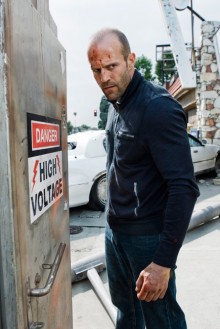
Welcome to our first attempt at a new feature currently called Movie Buzz—because I couldn’t think of anything better. This is by way of being something of an experiment. It’s even more of an experiment owing to the fact that I’m responsible for much of the technical end, as well as the content. Watch out.
The idea here is to create a kind of movie-related bulletin board that users are urged to interact with. All too often questions and heads-up notices get lost as off-topic posts, or they get overlooked because they’re made on reviews that have dropped off the main movie page. While I do receive notification of posts on older reviews, no one else does and so potentially worthwhile discussions go by the wayside. Hopefully, this planned weekly feature will help to prevent that.
This is also designed to broaden the range of movie-related topics. Instead of limiting ourselves to what’s in theaters or at the local film societies, this provides space to deal with new DVDs of interest and films that might be of interest on television. In this latter capacity especially, I’ll be hoping for input from readers since all I really follow are the listings for TCM (Turner Classic Movies) and FMC (Fox Movie Channel). I long ago gave up following the standard premium movie channels. For a movie critic, that’s just too much like being trapped in the previous year’s releases—except in the wrong aspect ratio more often than not. So if someone spots an interesting movie in one of those venues, please give us a heads-up.
New in Theaters
There are only three movies opening locally this week—17 Again, Crank: High Voltage and State of Play. After the unholy three of last week—Dragonball: Evolution, Hannah Montana: The Movie and Observe and Report—it’s reasonable to assume that this week will be an improvement. The chances of it being worse are roughly the same as hitting double-0 on a roulette wheel. I’m not saying that last week’s mainstream movies were without some educational value. If nothing else, it was yet another of those experiments in relativity. I thought Dragonball was bad, and then I saw Hannah Montana. At that moment, looked a whole lot better. Ah, but then I encountered Observe and Report whereupon Hannah Montana wasn’t looking so bad, and Dragonball was inching up to the level of quality entertainment.
Thankfully, the Fine Arts opened the very pleasant The Great Buck Howard, which almost no one went to see. You’ve a chance to rectify that this weekend, since it’s being held over for a second week.
My money’s on Crank: High Voltage as far as the new openings go. Sure, it’s an even more preposterous sequel to an already alarmingly preposterous original, but isn’t that the point? Despite the PR boys’ claims about it being “an adrenaline-fueled” action picture (didn’t they just use that on Taken?), did anyone see the trailer and not dissolve into helpless laughter and slack-jawed wonder at the absurdity of it all?
New DVDs of interest
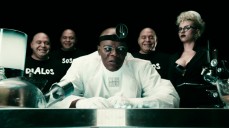
The Spirit and The Reader both come out on DVD this week. The former was one of the most reviled films of 2008—and yet it’s the one I’ll be picking up first. Hey, I’ve seen The Reader three times and I don’t feel the need to rush right out and see it again, though I will say it’s one of those movies you’re apt to admire more on subsequent viewings when you can better appreciate its astonishing craftsmanship. Even so, I really liked The Spirit—though I only saw it once—and think it got a bad rap from folks who perhaps take this sort of thing a little too seriously. It is to the comic book movie what the 1967 Casino Royale was to James Bond—a total send up of all the excesses of the real thing. Look at it in that light, and…hell, you might hate it even more.
Notable TV Screenings
Swing Time 10 p.m. Wed. April 15, TCM.
It’s Fred Astaire and Ginger Rogers in the best film of their career, George Stevens’ Swing Time (1936). This one has a particularly high place in my pantheon, not in the least because it helped to get me through the nigh-on to suicidally depressing Christmas of 1972, which was when I first saw it. I was a little skeptical at first, because I didn’t care for the title. “Swing” music is edging into a period of time where my interest in hot jazz and dance band music starts to wane. Well, I was wrong. Movies don’t come any more special than Swing Time and musical numbers don’t get any more heart-stoppingly beautiful than the “Never Gonna Dance” number.
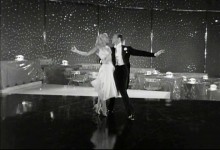
If you’ve never seen it, it’s a must. If you have seen it, you can’t see it too often. I’m particularly heartened to see that this showing is one of the “Viewers Choice” screenings, and that Swing Time was the choice of a 14-year-old boy.
All Day Charlie Chaplin-a-thon—Tillie’s Punctured Romance (1914), A Dog’s Life (1918), A Day’s Pleasure (1919), The Kid (1921), Pay Day (1922), A Woman of Paris (1923), The Gold Rush (1925), Modern Times (1936), The Great Dictator (1940), A King in New York (1957), The Chaplin Revue, conisting of A Dog’s Life, Shoulder Arms (1918), The Pilgrim (1923). From 6 a.m. till 8 p.m., Thu April 16, TCM.
No less than 14 hours of Chaplin that runs the gamut from his first starring feature to his last. If that’s a little daunting or 6 a.m. is a little early, skipping Tillie’s Punctured Romance isn’t a big deal, since it’s less a Chaplin vehicle than a Marie Dressler one in which Chaplin also stars. The Kid is a must, as are The Gold Rush and Modern Times. Actually, all Chaplin is a must, if it comes to that. Since this set appears to be drawn from films the Chaplin estate holds the rights to (Tillie to one side), chances are that the version of The Gold Rush being shown is Chaplin’s 1942 re-release, which he recut, scored, added a narration to and did away with the intertitles. The standard view is that the 1925 cut is preferable, but I’ve always found the later one to be quite charmingly done.
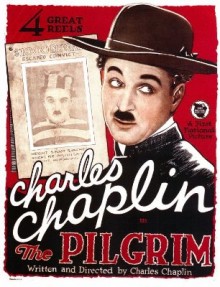
If at all possible, try to catch The Pilgrim, which is criminally underseen. This was Chaplin’s last short film (albeit a fairly long short) and it’s one of his best. It has Charlie as an escaped convict who gets mistaken for the new preacher in a small town. Chaplin’s pantomime of the story of David and Goliath is worth seeing the film for by itself. However, the kicker is the final image of Chaplin on the border of Mexico, having no place on either side of the border. Chaplin is well known for dynamic final images—the last shot from City Lights (1931) is one of the most memorable in all cinema—but this one has been oddly all but overlooked, and that oughtn’t be the case.
Blood and Sand (1941), 8 a.m., Fri April 17, Fox Movie Channel
Rouben Mamoulian completists (there’s gotta be somebody out there besides the late William K. Everson and me) might want to take note of this showing of Blood and Sand. It’s not a great film—with one exception, I don’t think Mamoulian made a great film after 1935—but it’s an interesting one, especially in its use of color. Mamoulian made the first three-color Technicolor feature, Becky Sharp (which is a great film, especially if you see a good print), back in 1935 and this was his second chance to dabble in the process. Actually, he more immersed himself in it that dabbled, using what he called “psychological” color—with the help of 16 cans of different color spray paints. The results are definitely something to see, even if the old bullfighter yarn (it had already been filmed 20 years earlier with Valentino in the lead) isn’t so hot.
Silk Stockings (1957), 11:30 p.m., Fri April 17, TCM
More Rouben Mamoulian—only this time it’s Mamoulian with a great film, the musical remake of Ninotchka (1939), which, frankly, strikes me as superior in almost every way to the original. The satire of Soviet Russia is expanded, and changing the centerpiece of the east-west struggle from some jewels to the fate of a Soviet composer (known for his “Ode to a Tractor”) who wants to write the music for a Hollywood movie is inspired. Fred Astaire and Cyd Charisse are perfect in the leads, while Janis Paige as the apparently water-logged movie star Peggy Dayton (“America’s Swimming Sweetheart”) is terrific. There’s also a singing and dancing (well, sort of) Peter Lorre, which is something you don’t see every day. And the Cole Porter songs are … well, they’re Cole Porter songs, which is enough. Mamoulian continues his experiments with color and adds Cinemascope, which he uses intelligently, even though he hated the format (“The worst shape ever devised”). This would be his last movie, and it’s a worthy climax.
Tales of Manhattan (1942), 6 a.m., Sat April 18, Fox Movie Channel
A whole bunch (14 to be exact) of writers—some pretty famous like Ben Hecht, Ferenc Molnar and Donald Ogden Stewart—got together to cook up the screenplay for French filmmaker Julien Duvivier’s portmanteau film Tales of Manhattan. As with most such projects, the results are uneven, though the film’s linking object—a fancy dress coat that we follow from its origins to its final fate on a scarecrow—is a better than usual concept. The stories themselves are variable. The best of them are the Charles Laughton episode, the Edward G. Robinson one, and the highly stylized and very strange final one with Paul Robeson, Ethel Waters and Eddie “Rochester” Anderson. The worst is a strained comedy segment with Ginger Rogers and Henry Fonda. A comedy sequence with W.C. Fields that was cut in 1942 has been reinstated in current prints, and while it’s not prime Fields, it’s nice to see. The blatantly communistic message of the last sequence is a surprising turn, to say the least. Visually, the film is rarely less than stunning.
Rings on Her Fingers (1942), 8:15 a.m., Sat April 18, Fox Movie Channel
This one really is for hardcore Rouben Mamoulian completists. Mamoulian tagged it the worst movie he ever made. He might be right. I haven’t seen it for 35 years and was overwhelmed by underwhelm when I did. It purports to be a comedy, but isn’t very funny. The concept is typical Henry Fonda as innocent young man from the hinterlands being taken by crooks. Laird Cregar has the film’s best—and most apt—line at the end when he says, “Ye gods, did you ever see anything so corny in your life?” Since it’s on right after Tales of Manhattan I’m inclined to give it another chance.
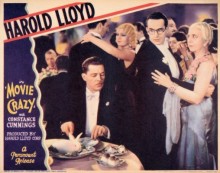
All Day Harold Lloyd Festival—High and Dizzy (1920), Never Weaken (1921), Girl Shy (1924), For Heaven’s Sake (1926), Feet First (1930), Movie Crazy (1932), The Cat’s Paw (1934), The Milky Way (1936), Harold Lloyd’s World of Comedy (1962), Harold Lloyd’s Funny Side of Life (1963)—6 a.m. till 8 p.m., Mon. April 20, TCM
I suspect it has something to do with having seen Harold Lloyd’s compilation film, Harold Lloyd’s World of Comedy, when I was seven or eight years old in a theater, but I’ve always liked Lloyd’s movies better than those of any of the silent comedians except Chaplin. Actually, this set of films has a pretty heavy dose of Lloyd’s talkies, which are too often overlooked. Feet First is a fairly clunky affair, but it is the sound film in which Lloyd recreates his famous hanging on the clock bit (originated in the 1923 Safety Last). Movie Crazy is a sweet little movie with two or three standout sequences. The strangest film here is The Cat’s Paw which casts Lloyd as missionary who gets involved in a tong war and helps to clean up a crime-riddled small town. What makes it particularly odd is the way the film plays to a vigilante mindset—almost to the point of fascism. All in all, this is a nice set of movies to introduce novices to Lloyd’s work.
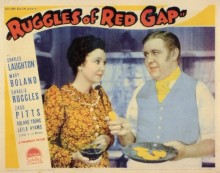
Ruggles of Red Gap (1935), 9:15 p.m, Mon. April 20, TCM
For me, this is the gem of the week and something I’ve been waiting for for about three months now. Leo McCarey’s Ruggles of Red Gap is the perfect blend of sentiment and comedy, one of the few instances where I find Americana particularly appealing—and it’s just possible McCarey’s masterpiece. Since McCarey is the guy who made the Marx Brothers’ Duck Soup (1933), that last is a tall statement, but I think the film bears it out. It stars Charles Laughton as a very proper English valet, who Charlie Ruggles wins from Roland Young in a card game in Paris. The idea appeals to Charlie Ruggles’ wife—played by Mary Boland—as a way of “civilizing” her roughneck husband. Also, the prospect of returning to the small western town of Red Gap with real English valet will be a social coup. The film is both warm and funny and perfectly cast. The scene where Leila Hyams teaches Roland Young to play the drums is pure magic. Laughton’s tendency to overplay and camp it up is here held in check by McCarey’s handling of the actor, which was apparently not always easy. Legend has it that one late night of shooting was so exasperating that McCarey snapped, “Charles, do you have to be so goddamned nancy?” Unmoved by the outburst, Laughton merely remarked, “Well, when you keep me here this late, it’s bound to show through.”




Before you comment
The comments section is here to provide a platform for civil dialogue on the issues we face together as a local community. Xpress is committed to offering this platform for all voices, but when the tone of the discussion gets nasty or strays off topic, we believe many people choose not to participate. Xpress editors are determined to moderate comments to ensure a constructive interchange is maintained. All comments judged not to be in keeping with the spirit of civil discourse will be removed and repeat violators will be banned. See here for our terms of service. Thank you for being part of this effort to promote respectful discussion.